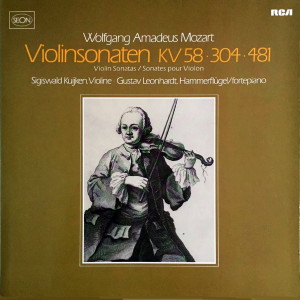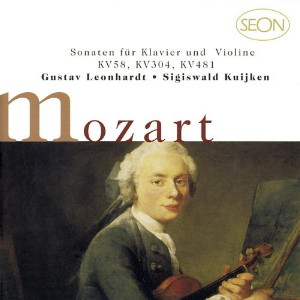 |
1 LP -
RL 30335 - (p) 1979
|
 |
| 1 CD -
SBK 62953 - (c) 1997 |
|
| VIOLINSONATEN
|
|
|
|
|
|
|
|
| Wolfgang Amadeus
MOZART (1756-1791) |
Sonata
in E-flat Major for Piano and Violin,
KV 58 |
|
8' 53" |
|
|
-
Adagio |
3' 26" |
|
A1
|
|
-
Menuetto: Moderato |
2' 20" |
|
A2 |
|
-
Rondo: Allegro assai |
2' 57" |
|
A3 |
|
Sonata
in E Minor for Piano and Violin, KV
304 |
|
13' 16" |
|
|
-
Allegro |
8' 27" |
|
A4 |
|
-
Tempo di Menuetto |
4' 49" |
|
A5 |
|
Sonata in E-flat Major for Piano
and Violin, KV 481 |
|
24' 35" |
|
|
-
Molto allegro |
7' 07" |
|
B1 |
|
-
Adagio |
8' 53" |
|
B2 |
|
-
Thema: Allegretto (in 6 variations) |
8' 35" |
|
B3 |
|
|
|
|
|
Gustav Leonhardt, Fortepiano (Anton Walter,
Vienna, c.1795-1805)
|
|
| Sigiswald Kuijken,
Violin (Naggini School, Brescia, mid-17th
century) |
|
|
|
|
|
Luogo
e data di registrazione |
|
Germanisches
Nationalmuseum, Nuremberg
(Germany) - Dicembre 1977
|
|
|
Registrazione: live
/ studio |
|
studio |
|
|
Producer /
Recording Supervisor |
|
Wolf Erichson
|
|
|
Recording Engineer
|
|
Dieter Thomsen
|
|
|
Prima Edizione LP |
|
Seon (RCA Red Seal) |
RL 30335 | 1 LP - durata 47' 20" |
(p) 1979 | ANA
|
|
|
Edizione CD |
|
Sony | SBK 62953 | 1
CD - durata 47' 20" | (c) 1997 |
ADD
|
|
|
Original Cover
|
|
J. H. van der Meer:
Violinspieler, aus Leopold Mozarts
"Violinschule", Kupferstich
|
|
|
Note |
|
- |
|
|
|
|
Mozart’s first
violin Sonatas (K.V. 55-60)
date from the time of his
journeys to Italy as a boy
(c.1772-1773). They are
still very much in the style
of the “sonatas for
pianoforte with violin
accompaniment”, as they were
then called, for the violin
itself receives very scanty
treatment. For the most part
it is allocated only
accompanying figures, little
bits of imitation or
sustained notes to fill out
the harmony - needless to
say, though, often to great
effect. The piano part, on
the other hand, has been
constructed with painstaking
care: it explores the
various pitches and Works
with very individual
figurations. As the violin is
not yet on an equal footing
with the piano in these
sonatas, there is no true
exchange between partners,
no “concertante” interplay.
The Sonata in E flat
major, K.V. 58 uses
the suite form for its
overall structural scheme.
It consists of a group of
dance-like movements in the
style of the earlier “sonata
da camera”. Mozart
altogether appears to have
been very impressed with the
art of the old Italian
masters such as Corelli and
Sammartini, for his
treatment of the bass line
and his melodic and rhythmic
structures in this sonata
often sound strangely
archaic. The Work is full of
contrasts and changing
moods. The Rondo is
relatively freely handled,
with one of its episodes in
the dark E flat minor key.
The Violin Sonata in E
minor, K.V. 304, like
the passionate A minor Piano
Sonata K.V. 310, was written
during Mozart’s unhappy
sojourn in Paris in 1778. It
is one of the six “Electress
Palatine” Sonatas (K.V.
301-306) that Mozart grouped
together as his Opus 1 to
dedicate to Maria Elisabeth,
Electress Palatine. In
keeping with French
tradition the sonata has two
movements. The work displays
great depths of emotion, at
times touching on the
dramatic, though always
keeping a measure of
restraint. In the first
movement stubborn defiance,
expressed in stormy unison
passages and slashing
syncopations, fights with
weary resignation. At
moments of particular
gravity Mozart inevitably
turns to counterpoint; here
he accentuates the
transitional passages and
the close with a canon. In
the second movement, too,
significantly headed “Tempo
di Minuetto” not “Minuet”,
the mood is predominantly
tragic, though the short E
major trio brings a welcome
respite. An intensely
passionate motive towards
the end of the movement
leads into a brief, almost
frantic outburst. Seldom did
Mozart write music so
acutely felt, so overladen
with personal tragedy as in
this fateful year.
The Violin Sonata in E
flat major, K.V. 481 is
one of great artistic
maturity and originality.
Its proximity to the violin
concertos of around 1785 is
apparent from its
virtuosity, concertante
treatment, wealth of ideas
and experimental zeal. In
the development section of
the virile yet congenial
first movement Mozart quotes
one of his favourite themes
from the F major Mass, using
it once more in the coda,
this time combined with the
main and final subjects. The
Adagio in A flat major is a
rondo, whose main theme is
varied each time it
reappears. Its
melismatically decorated
episodes are exquisite
examples of cantabile
writing. Rapturous and
sweeping, they lead the
music through a labyrinth of
modulations until it
culminates in an enharmonic
transformation. Never was
Mozart so near to Beethoven
as in this middle movement
and finale. In the final
movement Mozart gives six
variants of a popular
Viennese-Parisian tune, the
fourth attaining the status
of a genuine self-contained
character variation.
Lothar
Hoffmann-Erbrecht
Notes
on the piano-forte used
in this recording
For
this recording an historic
instrument from the Neupert
collection of keyboard
instruments housed in the
Germanisches Nationalmuseum
has been used, an early
piano (Hammerflügel) made by
Anton Walter of Vienna.
Anton Walter was born in
Württembrg, Germany, in
1752. He started up a
keyboard instrument workshop
in Vienna at the end of the
1770’s, continuing to run it
until his death in 1826. In
1790 he received the official
title of “Royal Imperial
Chamber Organ Builder and
Instrument Maker”. Shortly
before the year 1817 he
offered his stepson Johann
Joseph Schöffstoss a
partnership in the business.
Instruments made during this
last decade consequently
bear the signature “Walter
and Son”.
As a piano maker Walter had
a particularly good
reputation. Haydn knew him
and valued his work, and,
according to Czerny’s
memoirs, Beethoven had a
Walter piano-forte in his
flat in the winter of
1799-1800.
Konstanze Mozart records in
a letter to her son Carl in
1810 that Mozart’s own
pianoforte was a Walter
instrument. This instrument
is preserved in Salzburg in
the house where Mozart was
born.
Thanks to the considerable
number of Walter
piano-fortes that have
survived, the instrument’s
development can be fairly
accurately traced. It always
had the “Viennese action”,
with its light touch and
leather-covered hammers
allowing the characteristic
clear bright tone. Until
about the year 1795 the
compass of the instrument
was from F to f3, which
Mozart, for instance, never
exceeded in his piano works;
from about 1795 to about
1803 the compass was F’ -
g3, from about 1803 to about
1820 it was F'—c4, and
finally F’- f4. Mozart’s
piano-forte, made in about
1780, had only the five
octaves. The instrument on
this recording has a compass
of F'- g3, from which we
conclude that it was made
during the last few years of
the 18th century or the first
few years of the 19th.
Although it was made after
Mozart’s death this
piano-forte has the same
tone quality and timbre and
the same touch as the ones
made during his lifetime.
All the early pianos from
Walter’s workshop are
equipped with two register
stops: “forte” (raising of
the dampers) and
“moderator”. The use of this
latter stop interposes a
strip of cloth between the
leather-covered hammers and
the strings, which produces
a more muted tone quality.
It should be noted that this
stop actually changes the
timbre and consequently
contributes much more than
the modern “soft” pedal.
From about 1780 to about
1820 the registers on all
Viennese-made instruments,
including Walter’s, were
brought into action by
knee-operated devices, not
foot pedals. Pedal-work as
we know it from the modern
piano is therefore not
possible on this instrument,
neither is it necessary, as
these early Viennese
classical pianos sound
considerably more colourful
and brilliant than their
modern counterparts.
From the “Electress
Palatine” Sonatas (1778)
onwards (here represented by
the E minor Sonata) the
piano parts of these violin
sonatas - or piano sonatas
with violin accompaniments,
as they were then called -
were conceived with
qualities peculiar to the
piano-forte in mind. In the
case of the earlyviolin
sonatas, however, the
keyboard instrument
governing the style was the
harpsichord, although it
would have been quite
natural to use the
piano-forte, as at the time
the two instruments existed
side by side.
John
Henry van der Meer
English
translation by Avril
Watts
|
  |
|
|